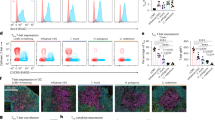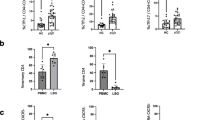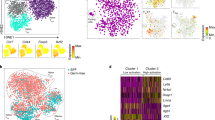Abstract
Type I interferon (IFN-I) is highly prevalent in autoimmune disorders and is intricately involved in disease pathogenesis, including Sjögren’s disease (SjD), also known as Sjögren’s syndrome. Although the T follicular helper (Tfh) cell response has been shown to drive SjD development in a mouse model of experimental Sjögren’s syndrome (ESS), the connection between IFN-I and the Tfh cell response remains unclear. As the activation of stimulator of interferon genes (STING) induces IFN-I production, we first demonstrated that mice deficient in STING or IFN-I signaling presented diminished Tfh cells and were completely resistant to ESS development. However, the STING–IFN-I axis does not directly influence Tfh cell differentiation. Instead, IFN-I signaling in B cells was essential for mounting Tfh cell responses, as evidenced in Cd19CreIfnar1flox mice, which also showed resistance to ESS development. Mechanistic analyses revealed that IFN-I drove CXCR5 expression in innate-like marginal zone B cells via the MEKK3–OCT2 axis, facilitating their migration into the follicular area. Additionally, IFN-I promoted interleukin-6 production in B cells via the MEKK3–ERK5 axis, resulting in hyperactive Tfh cell responses. In SjD patients, STING activation was predominantly observed in circulating CD14+ monocytes and was positively correlated with disease activity and effector T-cell responses. Pharmaceutical inhibition of either STING or IFNAR1 yielded moderate improvements in ESS mice with chronic inflammation, but combination therapy markedly improved outcomes and led to signs of disease remission. Our findings elucidate a novel mechanism by which IFN-I bridges innate and Tfh cell responses, suggesting new therapeutic avenues for SjD and related autoimmune disorders.
This is a preview of subscription content, access via your institution
Access options
Subscribe to this journal
Receive 12 digital issues and online access to articles
$119.00 per year
only $9.92 per issue
Buy this article
- Purchase on SpringerLink
- Instant access to full article PDF
Prices may be subject to local taxes which are calculated during checkout








Similar content being viewed by others
References
Nocturne G, Mariette X. Advances in understanding the pathogenesis of primary Sjogren’s syndrome. Nat Rev Rheumatol. 2013;9:544–56.
Brito-Zeron P, Kostov B, Solans R, Fraile G, Suarez-Cuervo C, Casanovas A, et al. Systemic activity and mortality in primary Sjogren syndrome: predicting survival using the EULAR-SS Disease Activity Index (ESSDAI) in 1045 patients. Ann Rheum Dis. 2016;75:348–55.
Fox RI. Sjogren’s syndrome. Lancet. 2005;366:321–31.
Seror R, Nocturne G, Mariette X. Current and future therapies for primary Sjogren syndrome. Nat Rev Rheumatol. 2021;17:475–86.
Lin X, Rui K, Deng J, Tian J, Wang X, Wang S, et al. Th17 cells play a critical role in the development of experimental Sjogren’s syndrome. Ann Rheum Dis. 2015;74:1302–10.
Fu W, Liu X, Lin X, Feng H, Sun L, Li S, et al. Deficiency in T follicular regulatory cells promotes autoimmunity. J Exp Med. 2018;215:815–25.
Crotty S. T follicular helper cell differentiation, function, and roles in disease. Immunity. 2014;41:529–42.
Craft JE. Follicular helper T cells in immunity and systemic autoimmunity. Nat Rev Rheumatol. 2012;8:337–47.
Bodewes ILA, Al-Ali S, van Helden-Meeuwsen CG, Maria NI, Tarn J, Lendrem DW, et al. Systemic interferon type I and type II signatures in primary Sjogren’s syndrome reveal differences in biological disease activity. Rheumatology (Oxf). 2018;57:921–30.
Nezos A, Gravani F, Tassidou A, Kapsogeorgou EK, Voulgarelis M, Koutsilieris M, et al. Type I and II interferon signatures in Sjogren’s syndrome pathogenesis: Contributions in distinct clinical phenotypes and Sjogren’s related lymphomagenesis. J Autoimmun. 2015;63:47–58.
Marketos N, Cinoku I, Rapti A, Mavragani CP. Type I interferon signature in Sjogren’s syndrome: pathophysiological and clinical implications. Clin Exp Rheumatol. 2019;37:185–91. Suppl 118.
Gujer C, Sandgren KJ, Douagi I, Adams WC, Sundling C, Smed-Sorensen A, et al. IFN-alpha produced by human plasmacytoid dendritic cells enhances T-cell-dependent naïve B-cell differentiation. J Leukoc Biol. 2011;89:811–21.
Ramos-Casals M, Brito-Zeron P, Bombardieri S, Bootsma H, De Vita S, Dorner T, et al. EULAR recommendations for the management of Sjogren’s syndrome with topical and systemic therapies. Ann Rheum Dis. 2020;79:3–18.
Paredes JL, Niewold TB. Type I interferon antagonists in clinical development for lupus. Expert Opin Investig Drugs. 2020;29:1025–41.
Kumar V. A STING to inflammation and autoimmunity. J Leukoc Biol. 2019;106:171–85.
Tanaka Y, Chen ZJ. STING specifies IRF3 phosphorylation by TBK1 in the cytosolic DNA signaling pathway. Sci Signal. 2012;5:ra20.
Domeier PP, Chodisetti SB, Schell SL, Kawasawa YI, Fasnacht MJ, Soni C, et al. B-cell-intrinsic type 1 interferon signaling is crucial for loss of tolerance and the development of autoreactive B cells. Cell Rep. 2018;24:406–18.
Kallies A, Hasbold J, Tarlinton DM, Dietrich W, Corcoran LM, Hodgkin PD, et al. Plasma cell ontogeny defined by quantitative changes in blimp-1 expression. J Exp Med. 2004;200:967–77.
McNab F, Mayer-Barber K, Sher A, Wack A, O’Garra A. Type I interferons in infectious disease. Nat Rev Immunol. 2015;15:87–103.
Swanson CL, Wilson TJ, Strauch P, Colonna M, Pelanda R, Torres RM. Type I IFN enhances follicular B-cell contribution to the T-cell-independent antibody response. J Exp Med. 2010;207:1485–500.
Yu D, Walker LSK, Liu Z, Linterman MA, Li Z. Targeting T(FH) cells in human diseases and vaccination: rationale and practice. Nat Immunol. 2022;23:1157–68.
Yu S, Zhou X, Liu R, Xu X, Ma D, Feng Y, et al. Immunomodulatory effects of Yu-Ping-Feng formula on primary Sjogren syndrome: interrogating the T-cell response. J Leukoc Biol. 2025;117:qiae155.
Parker M, Zheng Z, Lasarev MR, Larsen MC, Vande Loo A, Alexandridis RA, et al. Novel autoantibodies help diagnose anti-SSA antibody negative Sjogren disease and predict abnormal labial salivary gland pathology. Ann Rheum Dis. 2024;83:1169–80.
Robinson CP, Brayer J, Yamachika S, Esch TR, Peck AB, Stewart CA, et al. Transfer of human serum IgG to nonobese diabetic Igmu null mice reveals a role for autoantibodies in the loss of secretory function of exocrine tissues in Sjogren’s syndrome. Proc Natl Acad Sci USA. 1998;95:7538–43.
Weber JP, Fuhrmann F, Feist RK, Lahmann A, Al Baz MS, Gentz LJ, et al. ICOS maintains the T follicular helper cell phenotype by downregulating Kruppel-like factor 2. J Exp Med. 2015;212:217–33.
Merkenschlager J, Ploquin MJ, Eksmond U, Andargachew R, Thorborn G, Filby A, et al. Stepwise B-cell-dependent expansion of T helper clonotypes diversifies the T-cell response. Nat Commun. 2016;7:10281.
Nikbakht N, Shen S, Manser T. Cutting edge: Macrophages are required for localization of antigen-activated B cells to the follicular perimeter and the subsequent germinal center response. J Immunol. 2013;190:4923–7.
You Y, Myers RC, Freeberg L, Foote J, Kearney JF, Justement LB, et al. Marginal zone B cells regulate antigen capture by marginal zone macrophages. J Immunol. 2011;186:2172–81.
Attanavanich K, Kearney JF. Marginal zone, but not follicular B cells, are potent activators of naïve CD4 T cells. J Immunol. 2004;172:803–11.
Song H, Cerny J. Functional heterogeneity of marginal zone B cells revealed by their ability to generate both early antibody-forming cells and germinal centers with hypermutation and memory in response to a T-dependent antigen. J Exp Med. 2003;198:1923–35.
Kibler A, Budeus B, Homp E, Bronischewski K, Berg V, Sellmann L, et al. Systematic memory B-cell archiving and random display shape the human splenic marginal zone throughout life. J Exp Med. 2021;218:e20201952.
Cinamon G, Zachariah MA, Lam OM, Foss FW Jr, Cyster JG. Follicular shuttling of marginal zone B cells facilitates antigen transport. Nat Immunol. 2008;9:54–62.
Arnon TI, Horton RM, Grigorova IL, Cyster JG. Visualization of splenic marginal zone B-cell shuttling and follicular B-cell egress. Nature. 2013;493:684–8.
Palm AE, Kleinau S. Marginal zone B cells: From housekeeping function to autoimmunity?. J Autoimmun. 2021;119:102627.
Ise W, Fujii K, Shiroguchi K, Ito A, Kometani K, Takeda K, et al. T Follicular helper cell-germinal center B-cell interaction strength regulates entry into plasma cell or recycling germinal center cell fate. Immunity. 2018;48:702–15 e4.
Deng J, Wei Y, Fonseca VR, Graca L, Yu D. T follicular helper cells and T follicular regulatory cells in rheumatic diseases. Nat Rev Rheumatol. 2019;15:475–90.
Craig JE, Miller JN, Rayavarapu RR, Hong Z, Bulut GB, Zhuang W, et al. MEKK3-MEK5-ERK5 signaling promotes mitochondrial degradation. Cell Death Discov. 2020;6:107.
Choi JP, Wang R, Yang X, Wang X, Wang L, Ting KK, et al. Ponatinib (AP24534) inhibits MEKK3-KLF signaling and prevents formation and progression of cerebral cavernous malformations. Sci Adv. 2018;4:eaau0731.
Song S, Cao C, Choukrallah MA, Tang F, Christofori G, Kohler H, et al. OBF1 and Oct factors control the germinal center transcriptional program. Blood. 2021;137:2920–34.
Wang JH, Wu Q, Yang P, Li H, Li J, Mountz JD, et al. Type I interferon-dependent CD86(high) marginal zone precursor B cells are potent T-cell costimulators in mice. Arthritis Rheum. 2011;63:1054–64.
Arkatkar T, Du SW, Jacobs HM, Dam EM, Hou B, Buckner JH, et al. B-cell-derived IL-6 initiates spontaneous germinal center formation during systemic autoimmunity. J Exp Med. 2017;214:3207–17.
Kapellos TS, Bonaguro L, Gemund I, Reusch N, Saglam A, Hinkley ER, et al. Human monocyte subsets and phenotypes in major chronic inflammatory diseases. Front Immunol. 2019;10:2035.
Arvidsson G, Czarnewski P, Johansson A, Raine A, Imgenberg-Kreuz J, Nordlund J, et al. Multimodal single-cell sequencing of B cells in primary Sjogren’s syndrome. Arthritis Rheumatol. 2024;76:255–67.
Cerutti A, Cols M, Puga I. Marginal zone B cells: virtues of innate-like antibody-producing lymphocytes. Nat Rev Immunol. 2013;13:118–32.
Hu S, Gao Y, Gao R, Wang Y, Qu Y, Yang J, et al. The selective STING inhibitor H-151 preserves myocardial function and ameliorates cardiac fibrosis in murine myocardial infarction. Int Immunopharmacol. 2022;107:108658.
Kobritz M, Borjas T, Patel V, Coppa G, Aziz M, Wang P. H151, a small molecule inhibitor of sting as a novel therapeutic in intestinal ischemia‒reperfusion injury. Shock. 2022;58:241–50.
Bave U, Nordmark G, Lovgren T, Ronnelid J, Cajander S, Eloranta ML, et al. Activation of the type I interferon system in primary Sjogren’s syndrome: a possible etiopathogenic mechanism. Arthritis Rheum. 2005;52:1185–95.
Hong Z, Mei J, Li C, Bai G, Maimaiti M, Hu H, et al. STING inhibitors target the cyclic dinucleotide binding pocket. Proc Natl Acad Sci USA. 2021;118:e2105465118.
Okude H, Ori D, Kawai T. Signaling through nucleic acid sensors and their roles in inflammatory diseases. Front Immunol. 2020;11:625833.
Petri M, Bruce IN, Dorner T, Tanaka Y, Morand EF, Kalunian KC, et al. Baricitinib for systemic lupus erythematosus: a double-blind, randomized, placebo-controlled, phase 3 trial (SLE-BRAVE-II). Lancet. 2023;401:1011–9.
Chen W, Teo JMN, Yau SW, Wong MY, Lok CN, Che CM, et al. Chronic type I interferon signaling promotes lipid-peroxidation-driven terminal CD8(+) T-cell exhaustion and curtails anti-PD-1 efficacy. Cell Rep. 2022;41:111647.
Ray JP, Marshall HD, Laidlaw BJ, Staron MM, Kaech SM, Craft J. Transcription factor STAT3 and type I interferons are corepressive insulators for differentiation of follicular helper and T helper 1 cells. Immunity. 2014;40:367–77.
Wang W, Chong WP, Li C, Chen Z, Wu S, Zhou H, et al. Type I interferon therapy limits CNS autoimmunity by inhibiting CXCR3-mediated trafficking of pathogenic effector T cells. Cell Rep. 2019;28:486–97 e4.
Rouzaut A, Garasa S, Teijeira A, Gonzalez I, Martinez-Forero I, Suarez N, et al. Dendritic cells adhere to and transmigrate across lymphatic endothelium in response to IFN-alpha. Eur J Immunol. 2010;40:3054–63.
Peel JN, Owiredu EW, Rosenberg AF, Silva-Sanchez A, Randall TD, Kearney JF, et al. The marginal zone B-cell compartment and T-cell-independent antibody responses are supported by B-cell intrinsic expression of IRF1. J Immunol. 2024;213:1771–86.
Wang X, Cho B, Suzuki K, Xu Y, Green JA, An J, et al. Follicular dendritic cells help establish follicle identity and promote B-cell retention in germinal centers. J Exp Med. 2011;208:2497–510.
Wang JH, Li J, Wu Q, Yang P, Pawar RD, Xie S, et al. Marginal zone precursor B cells as cellular agents for type I IFN-promoted antigen transport in autoimmunity. J Immunol. 2010;184:442–51.
Nus M, Sage AP, Lu Y, Masters L, Lam BYH, Newland S, et al. Marginal zone B cells control the response of follicular helper T cells to a high-cholesterol diet. Nat Med. 2017;23:601–10.
Pan Z, Zhu T, Liu Y, Zhang N. Role of the CXCL13/CXCR5 axis in autoimmune diseases. Front Immunol. 2022;13:850998.
Wei C, Chen Y, Xu L, Yu B, Lu D, Yu Y, et al. CD40 signaling promotes CXCR5 expression in B cells via noncanonical NF-kappaB pathway activation. J Immunol Res. 2020;2020:1859260.
Emslie D, D’Costa K, Hasbold J, Metcalf D, Takatsu K, Hodgkin PO, et al. Oct2 enhances antibody-secreting cell differentiation through regulation of IL-5 receptor alpha chain expression on activated B cells. J Exp Med. 2008;205:409–21.
Lin X, Wang X, Xiao F, Ma K, Liu L, Wang X, et al. IL-10-producing regulatory B cells restrain the T follicular helper cell response in primary Sjogren’s syndrome. Cell Mol Immunol. 2019;16:921–31.
Zimmermann M, Arruda-Silva F, Bianchetto-Aguilera F, Finotti G, Calzetti F, Scapini P, et al. IFNalpha enhances the production of IL-6 by human neutrophils activated via TLR8. Sci Rep. 2016;6:19674.
Tan FH, Putoczki TL, Stylli SS, Luwor RB. Ponatinib: a novel multityrosine kinase inhibitor against human malignancies. Onco Targets Ther. 2019;12:635–45.
Haddad FG, Sasaki K, Nasr L, Short NJ, Kadia T, Dellasala S, et al. The results of ponatinib as frontline therapy for chronic myeloid leukemia in chronic phase. Cancer. 2024;130:3344–52.
Hoisnard L, Lebrun-Vignes B, Maury S, Mahevas M, El Karoui K, Roy L, et al. Adverse events associated with JAK inhibitors in 126,815 reports from the WHO pharmacovigilance database. Sci Rep. 2022;12:7140.
Meyts I, Casanova JL. Viral infections in humans and mice with genetic deficiencies of the type I IFN response pathway. Eur J Immunol. 2021;51:1039–61.
McInnes IB, Byers NL, Higgs RE, Lee J, Macias WL, Na S, et al. Comparison of baricitinib, upadacitinib, and tofacitinib mediated regulation of cytokine signaling in human leukocyte subpopulations. Arthritis Res Ther. 2019;21:183.
Lessard CJ, Li H, Adrianto I, Ice JA, Rasmussen A, Grundahl KM, et al. Variants at multiple loci implicated in both innate and adaptive immune responses are associated with Sjogren’s syndrome. Nat Genet. 2013;45:1284–92.
Walker MM, Crute BW, Cambier JC, Getahun A. B-cell-intrinsic STING signaling triggers cell activation, synergizes with B-cell receptor signals, and promotes antibody responses. J Immunol. 2018;201:2641–53.
Lin X, Song JX, Shaw PC, Ng TB, Wong RN, Sze SC, et al. An autoimmunized mouse model recapitulates key features in the pathogenesis of Sjogren’s syndrome. Int Immunol. 2011;23:613–24.
Acknowledgements
This work was supported by the General Research Fund, Hong Kong Research Grants Council (17109123, 17116521 and 27111820), the Mainland-Hong Kong Joint Funding Scheme (MHP/104/22) and the Health and Medical Research Fund (20212601 and 19201121). We are thankful for the technical support from the Center for PanorOmic Sciences (CPOS), University of Hong Kong. Professional English language editing support was provided by AsiaEdit.
Author information
Authors and Affiliations
Contributions
YC: Validation, Software, Investigation, Formal analysis, Writing—original draft. SY: Investigation. PHL: Resources. JX: Formal analysis, Visualization. IYT: Resources. HC: Investigation. HY: Investigation. XL: Writing—original draft, Writing—review & editing, Visualization, Supervision, Software, Project administration, Methodology, Investigation, Funding acquisition, Conceptualization.
Corresponding author
Ethics declarations
Competing interests
The authors declare no competing interests.
Additional information
Publisher’s note Springer Nature remains neutral with regard to jurisdictional claims in published maps and institutional affiliations.
Rights and permissions
Springer Nature or its licensor (e.g. a society or other partner) holds exclusive rights to this article under a publishing agreement with the author(s) or other rightsholder(s); author self-archiving of the accepted manuscript version of this article is solely governed by the terms of such publishing agreement and applicable law.
About this article
Cite this article
Chen, Y., Yu, S., Li, P.H. et al. The STING/type I interferon axis drives the interplay between marginal zone B cells and T follicular helper cells in Sjögren’s disease. Cell Mol Immunol (2025). https://doi.org/10.1038/s41423-025-01346-y
Received:
Revised:
Accepted:
Published:
DOI: https://doi.org/10.1038/s41423-025-01346-y



